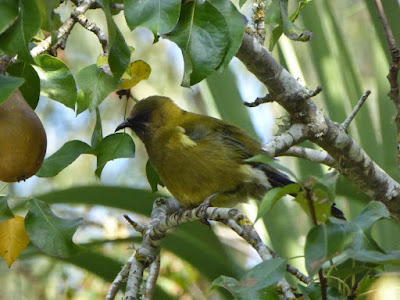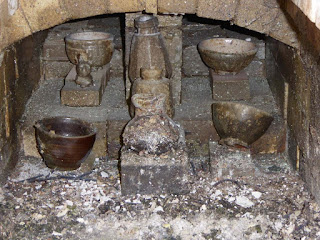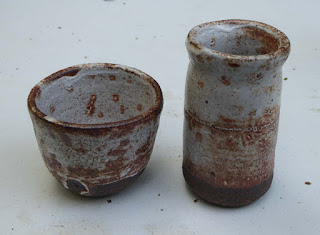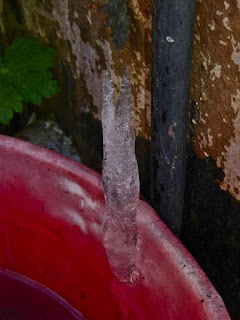Out of the Fire! New Pots from the Wood Fired Kiln!
I took down the kiln door whilst a Bell Bird sang merrily and enjoyed ripe pears from a high perch in our pear tree!
The door is made from insulating fire bricks which are very light in weight and become rather fragile after a few firings. It is amazing to think that a thickness of just 4 and a half inches of these bricks is enough to contain the searing 1300 C (2372 F) heat that is in the chamber of the kiln at the peak of the firing.
There is a lot of work to be done to ready a wood fired kiln for unloading, and it is quite a "moment" when the chamber is open at last and it is possible to have a good look at the pots that are inside. It took 3 days of cooling to get to the point when the door could be opened, and I have to leave everything for an hour or so more to ensure that the work is all down to about the temperature of a freshly laid hen's egg before removing it from its sanctuary and introducing it to the world!
At the back of the firebox was a useful place for certain pots that we wanted to really get hit by flame and ash. Whilst the first glance is like looking at the aftermath of an atomic bomb test, most of the work scrubbed up very well when cleaned in a bucket of fresh water, and Jim who shared some kiln space with me, had some exciting looking pots.
Unfortunately I did not manage to take any photos of Jim's pots from the firebox of the kiln, but these Shino glazed pots of his were from further in the kiln where they still received plenty of direct flame and heat, but not as much ash.
My pupil, Becky, had some lovely small pouring bowls in this firing that were glazed with "Red Reserve", a very reliable saturated iron glaze that can be found in "The Potter's Companion" by Tony Birks (an excellent "must have" book that you may be able to find second-hand somewhere).
Here are Becky's pouring bowls. These reached at least cone 11, but "Red Reserve" is a glaze that copes with heat very well and is static without being boring!
As this was something of a test firing I took the opportunity to try several glazes that I was unfamiliar with, two that peaked my interest were a strontium matte and a barium matte glaze. You can see the barium matte at the front in the middle of the top shelf. Barium* and Strontium can enhance colour in glazes, particularly glazes that contain some copper.
 |
| Strontium Matte ( white stoneware 12 x 6 inches, 305 x 150mm) |
 |
| Barium Matte (white stoneware 12.25 x 6.5 inches, 317 x 165mm) |
The strontium matte had a more uniform colour, but the barium matte changed dramatically from green to blue where the glaze was thickest. Both have a really interesting sparkling surface from numerous tiny crystals that have formed in the glaze.
A few of the freshly unloaded pots sitting in the late afternoon sunshine. There are a few of Jim's pots on the left of the photo, and some melted pyrometric cones in front of them. The rest of the pots are mine. I mostly had used celadon, copper red, saturated iron and shino glazes in this firing. Jim had used mostly shino and occasionally celadon.
 |
| Copper Red 7.5 x 6.25 inches, 190 x 165mm |
In spite of having difficulty controlling reduction in this firing, this copper red was very forgiving and gave good results. Unfortunately, the mirror finish ensured that it was almost impossible for me to photograph without reflections!
 |
| Copper Red/Green 6 x 5 inches, 150 x 130mm |
 | |
| Saturated iron glaze 6.5 x 5 inches, 150 x 130mm |
 | |
| Iron Red 7.5 x 9 inches, 190 x 230mm |
This one is glazed with "Red Reserve" from the book by Tony Birks. It isn't a bright red, but more a refined dark purple colour that reminds me for some reason of vintage sports cars!
 |
| A "golden shino" 8.5 x 7 inches, 215 x 180mm |
This one came out more of a mirror bronze in colour with some ash flecks giving the surface some extra interest.
 |
| Mystery glaze! 7.5 x 4.5 inches, 190 x 115mm |
I am fairly sure that this little bottle was glazed with a new batch of a white shino glaze that I made up then added 3 percent iron oxide to. I am surprised by how dark it is.
 |
| Iron green (celadon) glaze, 7.5 x 6.5 inches, 190 x 165mm |
Many "flavours" of celadon glazes can be made, from gentle pale blue, through pale grey to quite a dark green. All get their colour from iron oxide that is fired in a reduction atmosphere if they really are celadon glazes! Many people now are more used to "celadon" that is from copper or chromium fired in oxidation in an electric kiln.
 |
| Celadon bowl, 5.5 x 8.75 inches, 140 x 220mm |
This firing could not have been possible without the assistance and encouragement of several special people.
Jim, who really wanted to do another wood firing and provided much of the wood and did a lot of stoking when we were pushing through some of the more difficult and arduous hours of the firing.
Becky, who has persevered with potting in spite of her busy life, and has been a great encouragement to Laura and myself over the years.
And especially Laura, who has supported and encouraged throughout the entirety of this potting adventure, and does so many helpful and practical things throughout the firing of the kiln, both at the kiln side and also in the kitchen!
*Note
Yes, Barium Carbonate is a poison, just a spoonful if eaten could kill you. Once it has been fired and made into a glass, it is of course much safer, however it is not recommended these days as an ingredient of a glaze that will come in contact with food or drink. It is also good to wear rubbler gloves when working with Barium in glazes. Strontium Carbonate can often be used as a non toxic substitute for Barium.















Comments
Well done all.
I can't say I fancy using either barium or strontium carbonate!! But a small amount on a pot of those colours can set it off...a whole pot in those colours I feel overpowering
Smartcat aka suzi (incase I am still being anonymous!)
Lovely to hear from you both! It was good to have got some pots through the wood fired kiln again, and always a bit of an epic to get to that point!
Regards barium and strontium, barium is definitely poisonous, but strontium (in the form that potters use) is non-toxic and there were high hopes of using it in frits to replace lead in low temperature glazes before boron became popular. I realise that strontium carbonate is sometimes confused with strontium 90 or the highly inflammable strontium nitrate used in fireworks to make pretty reds, but they are not the same as strontium carbonate.
As to colour, they are good fun! I liked the strontium matte better than the barium in this test, it is very interesting both for colour and texture.
Very nice to hear from you, thank you for the encouragement :-)